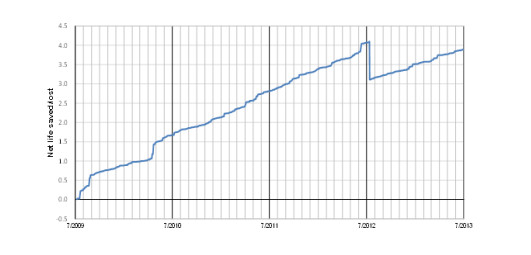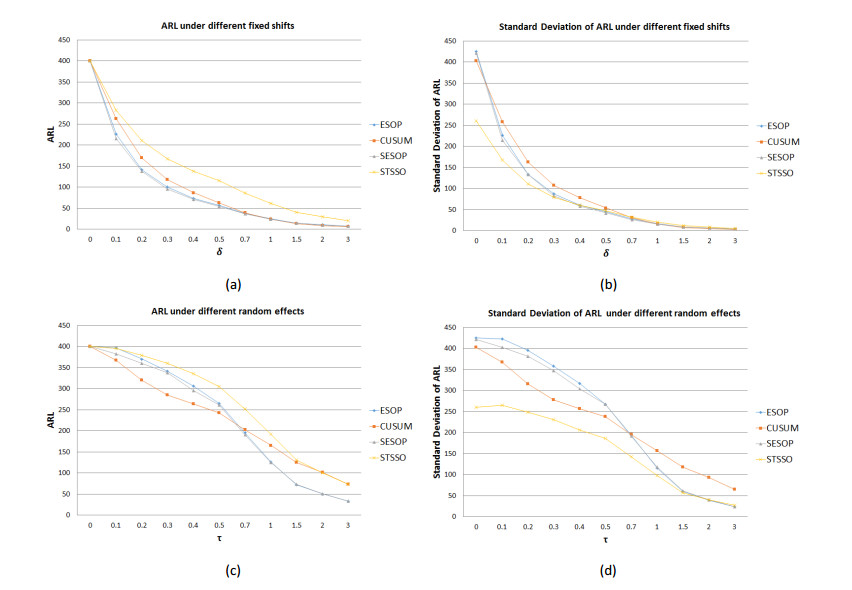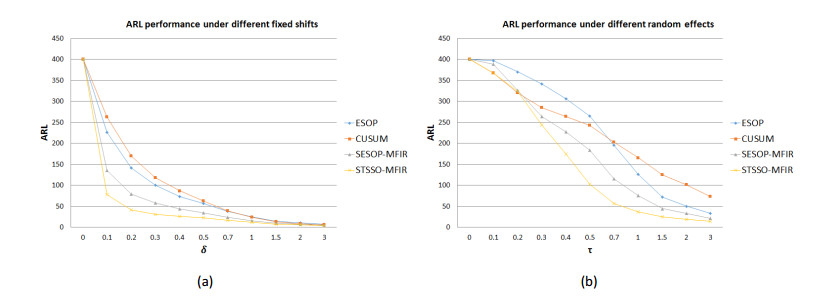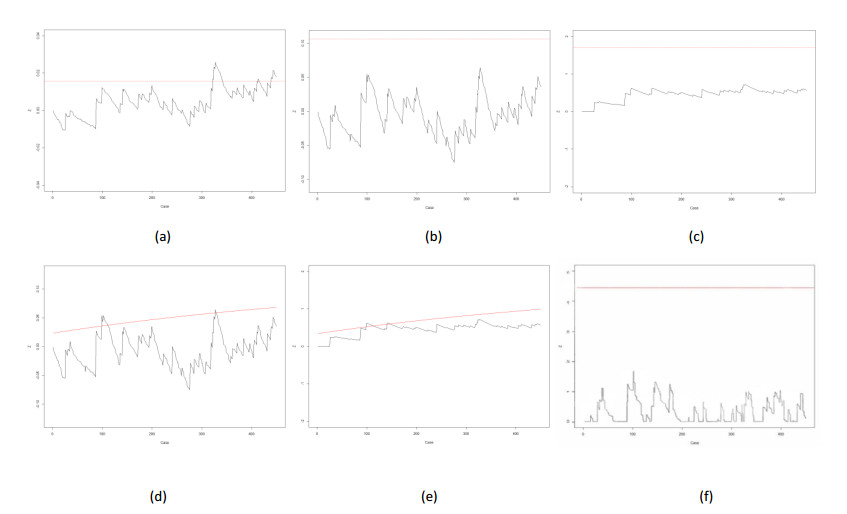|
[1]
|
W. H. Woodall, S. L. Fogel, S. H. Steiner, The monitoring and improvement of surgical outcome quality, J. Qual. Technol., 47 (2015), 383-399. doi: 10.1080/00224065.2015.11918141

|
|
[2]
|
K. Paynabar, J. Jin, A. B. Yeh, Phase I risk-adjusted control charts for monitoring surgical performance by considering categorical covariates, J. Qual. Technol., 44 (2012), 39-53. doi: 10.1080/00224065.2012.11917880

|
|
[3]
|
M. Douglas, Z. Song, Y. Liu, J. Zhang, A comparative study of memory-type control charts based on robust scale estimators, Qual. Reliab. Eng. Int., 34 (2018), 1079-1102. doi: 10.1002/qre.2309

|
|
[4]
|
J. S. Hunter, The exponentially weighted moving average, J. Qual. Technol, 18 (1986), 203-210. doi: 10.1080/00224065.1986.11979014

|
|
[5]
|
A. Ingolfsson, E. Sachs, Stability and sensitivity of an EWMA controller, J. Qual. Technol., 25 (1993), 271-287. doi: 10.1080/00224065.1993.11979473

|
|
[6]
|
S. V. Crowder, M. D. Hamilton, An EWMA for monitoring a process standard deviation, J. Qual. Technol., 24 (1992), 12-21. doi: 10.1080/00224065.1992.11979369

|
|
[7]
|
R. B. Crosier, A new two-sided cumulative sum quality control scheme, Technometrics, 28 (1986), 187-194. doi: 10.1080/00401706.1986.10488126

|
|
[8]
|
L. Shu, W. Jiang, K. L. Tsui, A comparison of weighted CUSUM procedures that account for monotone changes in population size, Stat. Med., 30 (2011), 725-741. doi: 10.1002/sim.4122

|
|
[9]
|
J. J. Pignatiello, G. C. Runger, Comparisons of multivariate CUSUM charts, J. Qual. Technol., 22 (1990).
|
|
[10]
|
J. Lovegrove, O. Valencia, T. Treasure, C. Sherlaw-Johnson, S. Gallivan, Monitoring the results of cardiac surgery by variable life-adjusted display, Lancet, 350 (1997), 1128-1130. doi: 10.1016/S0140-6736(97)06507-0

|
|
[11]
|
T. Treasure, O. Valencia, C. Sherlaw-Johnson, S. Gallivan, Surgical performance measurement, Health Care Manag. Sci., 5 (2002), 243-248. doi: 10.1023/A:1020373921395

|
|
[12]
|
C. W. Champ, W. H. Woodall, Signal probabilities for runs supplementing a shewhart control chart, Commun. Statist. Simulat. Comput., 26 (1997), 1347-1360.
|
|
[13]
|
J. M. Lucas, Combined Shewart-CUSUM quality control schemes, J. Qual. Technol., 14 (1982), 51-59. doi: 10.1080/00224065.1982.11978790

|
|
[14]
|
L. S. Nelson, The Shewhart control chart-tests for special causes, J. Qual. Technol., 16 (1984), 237-239. doi: 10.1080/00224065.1984.11978921

|
|
[15]
|
J. Neuburger, K. Walker, C. Sherlaw-Johnson, J. Meulen, D. A. Cromwell, Comparison of control charts for monitoring clinical performance using binary data, BMJ Qual. Safety, 26 (2017), 919-928. doi: 10.1136/bmjqs-2016-005526

|
|
[16]
|
S. H. Steiner, W. H. Woodall, Debate: what is the best method to monitor surgical performance, BMC Surg., 16 (2016), 15. doi: 10.1186/s12893-016-0131-8

|
|
[17]
|
X. Zhang, W. H. Woodall, Reduction of the effect of estimation error on in-control performance for risk-adjusted Bernoulli CUSUM chart with dynamic probability control limits, Qual. Reliab. Eng. Int., 33 (2016), 381-386.
|
|
[18]
|
L. Liu, X. Lai, J. Zhang, F. Tsung, Online profile monitoring for surgical outcomes using a weighted score test, J. Qual. Technol., 1 (2018), 88-97.
|
|
[19]
|
D. A. Cook, S. H. Steiner, R. J. Cook, V. T. Farewell, A. P. Morton, Monitoring the evolutionary process of quality: risk-adjusted charting to track outcomes in intensive care, Crit. Care. Med., 31 (2003), 1676-1682. doi: 10.1097/01.CCM.0000065273.63224.A8

|
|
[20]
|
S. H. Steiner, R. J. Cook, V. T. Farewell, T. Treasure, Monitoring surgical performance using risk adjusted cumulative sum charts, Biostatistics, 1 (2000), 441-452. doi: 10.1093/biostatistics/1.4.441

|
|
[21]
|
J. Yue, X. Lai, L. Liu, P. Lai, A new VLAD-based control chart for detecting surgical outcomes, Stat. Med., 36 (2017), 4540-4547. doi: 10.1002/sim.7362

|
|
[22]
|
X. Zhang, W. H. Woodall, Dynamic probability control limits for risk-adjusted Bernoulli CUSUM charts, Stat. Med., 34 (2015), 3336-3348. doi: 10.1002/sim.6547

|
|
[23]
|
D. A. Cook, M. Coory, R. A. Webster, Exponentially weighted moving average charts to compare observed and expected values for monitoring risk-adjusted hospital indicators, BMJ Qual. Safety, 20 (2011), 469-474. doi: 10.1136/bmjqs.2008.031831

|
|
[24]
|
T. Treasure, S. Gallivan, C. Sherlaw-Johnson, Monitoring cardiac surgical performance: A commentary, J. Thorac. Cardiov. Sur., 128 (2004), 823-825. doi: 10.1016/j.jtcvs.2004.03.023

|
|
[25]
|
O. Grigg, V. T. Farewell, A risk-adjusted sets method for monitoring adverse medical outcomes, Stat. Med., 23 (2004), 1593-1602. doi: 10.1002/sim.1763

|
|
[26]
|
S. H. Steiner, EWMA control charts with time-varying control limits and fast initial response, J. Qual. Technol., 31 (1999), 75-86. doi: 10.1080/00224065.1999.11979899

|
|
[27]
|
J. M. Lucas, R. B. Crosier, Fast initial response for CUSUM quality-control schemes: give your CUSUM a head start, Technometrics, 24 (1982), 199-205. doi: 10.1080/00401706.1982.10487759

|
|
[28]
|
A. Haq, J. Brown, E. Moltchanova, Improved fast initial response features for exponentially weighted moving average and cumulative sum control charts, Qual. Reliab. Eng. Int., 30 (2014), 697-710. doi: 10.1002/qre.1521

|
|
[29]
|
S. Knoth, Fast initial response features for EWMA control charts, Stat. Pap., 46 (2005), 47-64. doi: 10.1007/BF02762034

|
|
[30]
|
M. J. Silvapulle, P. Silvapulle, A score test against one-sided alternatives, J. Am. Stat. Assoc., 90 (1995), 342-349. doi: 10.1080/01621459.1995.10476518

|
|
[31]
|
S. K. Sinha, Bootstrap tests for variance components in generalized linear mixed models, Can. J. Stat., 37 (2009), 219-234. doi: 10.1002/cjs.10012

|


















 DownLoad:
DownLoad: